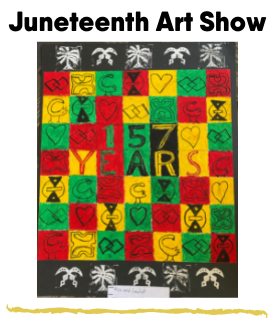
In honor of Juneteenth, art teachers Judy Klima from Edmunds Middle School, and Tina Logan from A.D.L. Middle School collaborated on an art assignment for their middle school students. We wanted our students to merge the importance of this holiday with the rich history and beautiy of Ghanaian textiles.
Students first dove into the history of Juneteenth. Next, students looked at African textiles produced in Ghana: Kente cloth and Adinkra cloth. For almost 150 years, Ghana, on Africa's west coast, was the center of the British slave trade. Western traders arrive in ships loaded with manufactured goods to barter or trade for slaves.
Kente cloth refers to a Ghanaian textile, made of handwoven cloth, strips of silk and cotton. Historically the fabric was worn in a toga-like fashion by royalty amon ethnic groups such as the Ashanti and Ewe. In modern-day Ghana, the wearing of Kente cloth has become widespread to commemorate special occasions, with highly sought after Kente brands led by master weavers. Kente cloth is rich with geometric patterns.

Adinkra (ah-DEEN-krah) cloth is a hand-printed fabric made in Ghana. Developed by the Ashanti people, Adinkra cloths were traditionally made for royalty to wear at religious ceremonies. Through the years, people have also decorated the cloths to tell a story or to express their thoughts or feelings. The earliest known adinkra cloth dates from 1817 and consists of twenty-four handwoven stripgs of undyed cotton cloth, each about three inches wide and woven on the same type of narrow strip horizontal treadle loom as Asante kente. The strips are sewn selvage to selvage and are stamped with these symbols.
Artistic Process
Students chose a quote or saying from a notable BIPOC individual, or used a Juneteenth slogan to create abstract designs. Colors were chosen symbolically, referenced from African Textiles, and or colors from African and American flags. Borders were made using Adinkra symbols that had personal meaning to each student. Some students worked individually while others worked in collaborative groups.
The following mediums were used to create these festive posters:
Watercolor
Gouache
Acrylic
Oil pastels
Crayon
Paint pens
Block printing materials